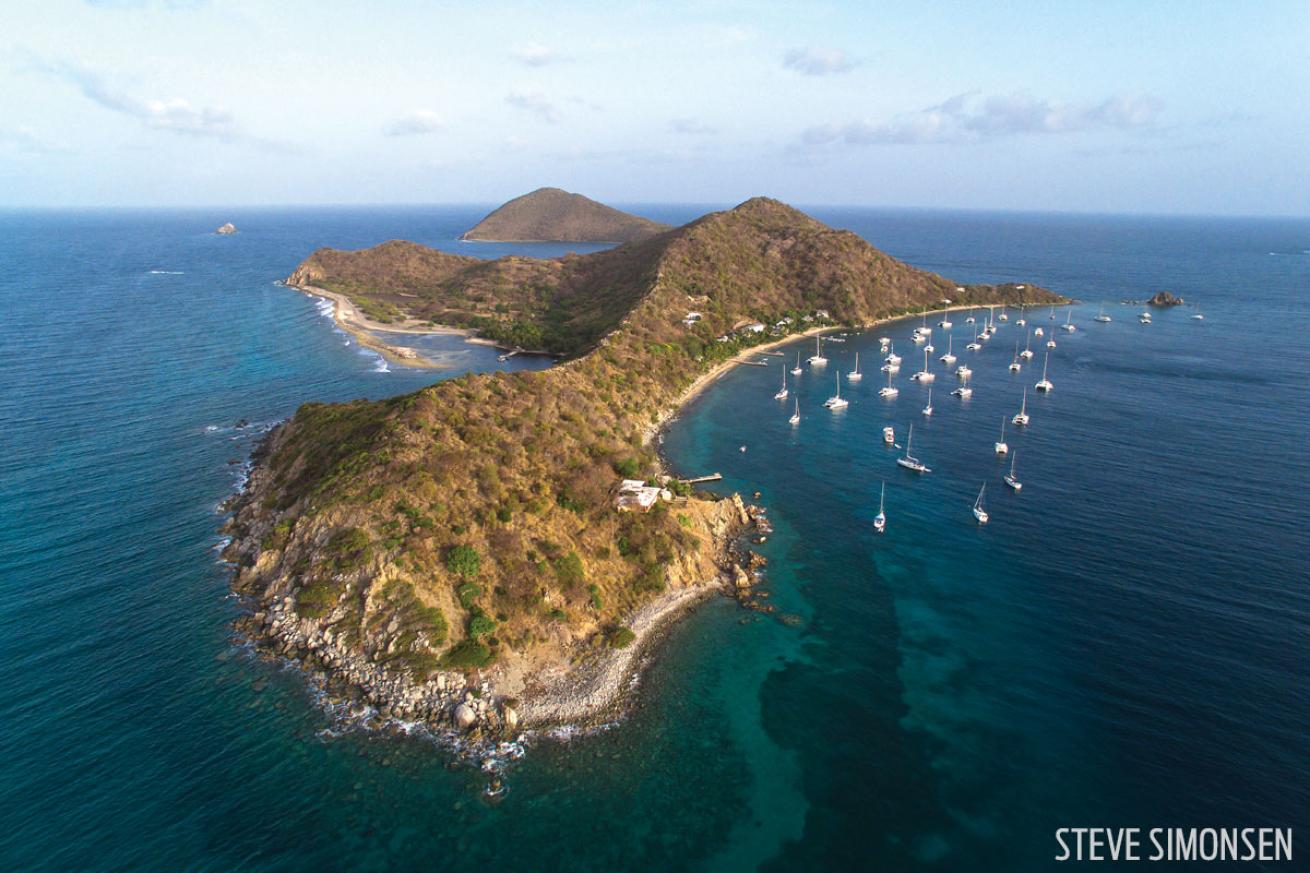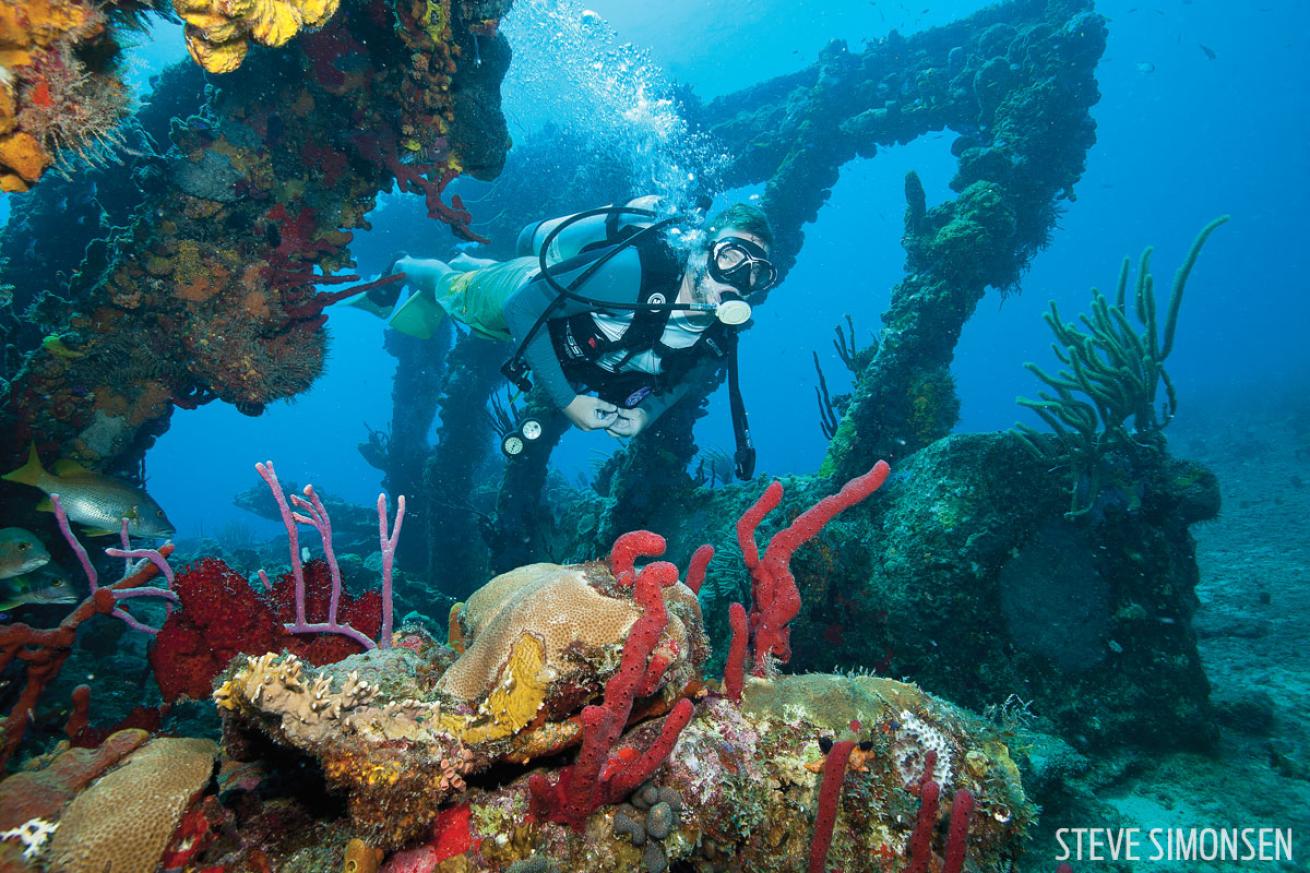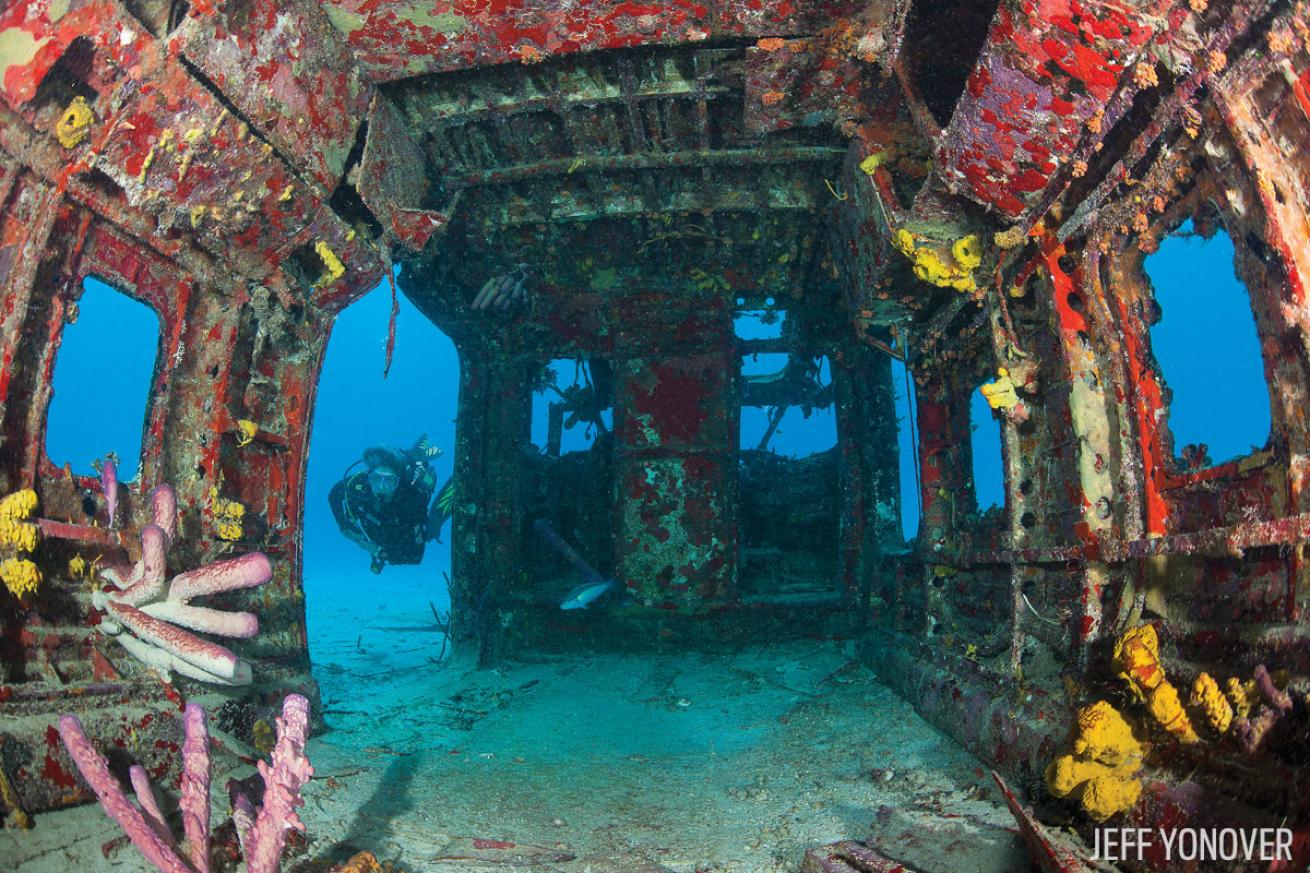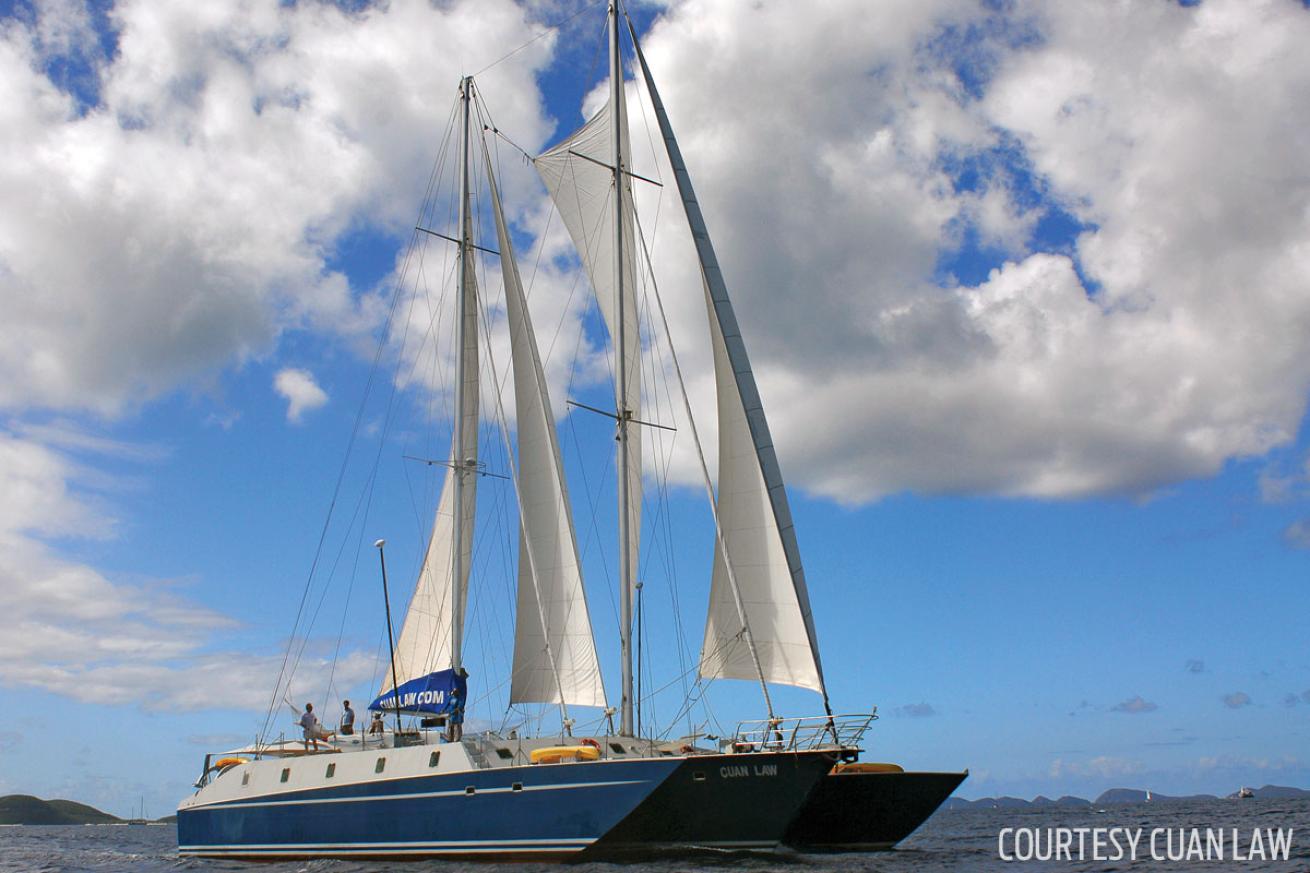The Cuan Law Is Not Your Typical Liveaboard
The Civilized Life: Cuan Law trimaran is all about graceful living — and scuba diving — in the British Virgin Islands

Steve SimonsenA popular stop-off for charters: the Rum Bar at the Cooper Island Beach Club.
It’s a story to rival James Cameron’s Titanic. Two captains, unaware that an approaching storm is a hurricane of epic proportions, agree to transfer passengers from the smaller vessel to the “unsinkable” RMS Rhone, one of the most innovative sail-steam ships of the 1860s. The smaller ship will risk a run for Tortola across Sir Francis Drake Channel while Rhone heads for the safety of open seas. But just as the royal mail packet is about to clear Salt Island, the winds change direction, shoving Rhone stern-first against Black Rock Point and sweeping its captain overboard, never to be seen again. Most of the 146 souls aboard — plus an unknown number from the smaller ship, all lashed to their bunks for safety — quickly perish, except for a couple dozen crew members who survive the sinking but not the storm, their stone-marked graves visible today on the desolate island.
It’s an odd subject for comedy. But the crew of Cuan Law has us howling at an “interactive” skit designed to educate us about the legendary wreck. Guests play passengers and the ill-fated captain. “Well, I can’t play him!” says Cuan Law’s South African skipper Jamie Deehan, 25. “How would that look?” “Jamie likes to be the rain,” whispers our narrator, dive instructor Chris Thompson, 33, letting us know there’s a dousing coming for somebody.
Maryanne “Mo” Ormsby, 56, is aboard with five divers from her local club, the 150-strong Aqua-Nuts of Horsham, Pennsylvania’s Underwater World dive shop. She kills as a first-class passenger mostly worried about her prosecco, a frosty flute Ormsby is desperately trying to protect from that “rain.”
It’s her first time diving in the British Virgin Islands, and her first liveaboard trip. “I just realized I have not worn shoes for a week. That is so awesome,” she says later. She grows more philosophical talking about Rhone. “It’s neat to see that wrecks like that end up supporting new life.”

Steve SimonsenThe Rhone is a great structure dive for divers.
We had descended on Rhone’s bow in a strong current that delayed some divers getting to the sand at about 80 feet, giving the rest time to examine the massive foremast and mostly intact crow’s nest. Lying on its starboard side, the 310-foot ship — wrenched across a huge debris field that yields multiple dives — easily admits divers into the heart of the iron-hulled vessel. Its frames are plainly evident in the open hold, giving divers a feeling akin to Jonah entering the whale, except that this living interior is entirely encrusted in colorful sponges and cup corals. It’s majestic, inspiring — and a little sobering.
A CUT ABOVE
Cuan Law is not your typical liveaboard. There is no divedeck camera table, nor even a dive deck per se (more on that in a moment). You will not dive five times a day. What you will find is a gorgeously appointed, fully rigged schooner — the world’s largest trimaran — where you will be waited on pretty much every minute. Meals and dives both are staged from a canopied 40-foot-wide teak deck at the stern.
“We’re somewhere between a yacht charter and a dive liveaboard,” Deehan explains when I exclaim over the size of my cabin, with its porthole, two skylights and large bathroom. Cheryl Wood, 48, and her husband, Chris, 52, of Collierville, Tennessee, have done Bahamas’ Aqua Cat three times. When that boat was booked, they decided to try Cuan Law.
“If you’re looking to log tons of dives, this isn’t that,” Chris Wood says. “This is more relaxed, a slower pace and a great balance” between diving and other activities.
“This is more about R&R,” Cheryl Wood adds, pointing to the variety of activities aboard. “The Hobie Cats” — Cuan Law carries two — “the kayaks, tubes, skiing — it’s a lot of fun.”

Jeff YonoverA purpose-sunk plane off Great Dog.
The BVI’s best diving is all about structure — natural and man-made — rather than big animals, not discounting the eagle rays and turtles we see on many dives. From our checkout at tiny Ollie’s Wreck off Ginger Island to a full day of diving on Rhone to the twice-sunk wreck of a small BVI Airways plane — once on purpose; the first time, not so much — now resting off Great Dog Island, there are plenty of ruins to explore.
Although there are healthy gorgonians everywhere, and all the usual Caribbean reef fish, it’s the landscape that impresses. On a night dive at Cistern Point off Cooper Island, we cruise in light current through beautiful low-rise canyons, their walls plastered with mind-blowing color and texture made almost painfully vivid in our lights, so ornate and richly covered that it’s like passing through rooms at the Vatican, or Versailles. At the Chimney, also off Great Dog, we meander through shallow stone gardens with small elkhorn coral glowing in the sun. Huge, chiseled underwater cliffs that end in giant blocky boulders with broad avenues between inspire awe at Times Square, off Guana Island. In limited viz, the inhuman scale produces an eerie splendor, and monster breakers crash against the rocks above so loudly that you can feel it reverberate in your chest.
VIRGIN QUEEN
Near the end of our trip, we have the chance to dive a purpose-sunk wreck down only a month. Kodiak Queen, off Virgin Gorda’s Mountain Point, has gotten a lot of attention for the 80-foot sculpture of a kraken attached to the 155-foot wreck, one of few survivors of the Pearl Harbor attack. It’s a perfectly prepared playground for divers, who can penetrate the light-filled wreck via multiple points — you can even swim into the kraken’s giant head, destined to be a fish nursery, its creators hope. Already an adorable school of baby fusiliers flits around after us like a flock of birds.
It’s an entertaining dive, and will be fun to revisit in future, but my thoughts keep returning to Rhone — the spectacular centerpiece of the week — and a night dive that only a few divers opt for.
This time there’s zero current. We sink through dark, silky seas, feeling like the first explorers to behold this splendid ship. Our lights fall on a big group of arrow crabs and cleaner shrimp, and then we turn in to the hold. The entire overhead arch is a massive carpet of canary-yellow cup corals — magical. We exit and head for the ship’s midsection and boiler; little eyes flash everywhere in our lights, and sometimes big ones, as the chrome scales of huge tarpon suddenly hove into view. We hear a whoop from behind — one diver has found an octopus, shifting rapidly from mint green to white to pomegranate.
Time begins to run short, but no one wants to leave Rhone. We mill around the mooring line at last, not wanting to admit we cannot stay in this world. Surfacing, we climb back into the tender under an inky sky etched with stars. It just doesn’t get much better than this.

Courtesy Cuan LawAll Star Liveaboards operates the Cuan Law.
5 REASONS TO DIVE CUAN LAW
1) SAIL AWAY
Unlike some exotic liveaboards, the sails here are not just for show — you will be under sail often.
2) RELAX
If there’s a more blissful way to spend a surface interval than rocking gently in one of Cuan Law’s two sail-deck hammocks, I
haven’t heard it.
3) PARTY
How many liveaboards have an open, full-liquor bar included, and someone to tend it? (And crew who will keep an eye on you after you become a snorkeler for the day.)
4) WATER, WATER
Don’t feel like diving? How about a Hobie Cat lesson? Or maybe you fancy tubing behind a tender? Water skiing? It’s all available.
5) THE BATHS
All cruises end with a picnic and beach hike through this extraordinary natural stone phenomenon at the tip of Virgin Gorda, a beautiful end to a perfect trip.
WHEN TO GO
Cuan Law operates year-round, except for a month or so in late summer or early fall for maintenance. Diving conditions are good year-round, but trade winds and swell are lighter in summer.
DIVE CONDITIONS
Water temps vary from about 78 degrees in winter, when you’ll need a light wetsuit or layers, and 82 degrees in summer, when a skin or bathing suit is fine. BVI dive sites can experience current, but with 100 sites to choose from, the crew is adept at shifting plans when needed and often puts a divemaster in the water first to check conditions. Visibility can range from 40 feet or so when affected by wind or tides up to 100 feet on clearer days.
OPERATOR
Cuan Law is a 105-foot trimaran with a 44-foot beam that sails out of Tortola. Its 10 staterooms accommodate up to 20 divers; all cabins can be configured with a queen bed or two twins. As of September 2016, Annie and Duncan Muirhead, Cuan Law owners, have signed All Star Liveaboards to manage marketing and reservations.
PRICE TAG
Six nights’ accommodations with meals, drinks and watersports including diving is $2,845 per person, double occupancy. Equipment rental, nitrox, transfers and tips are not included. Cuan Law also can be chartered as a whole boat.










